Beach Boys

Clockwise from bottom left: Al Jardine,
Dennis Wilson, Brian Wilson, Carl Wilson, Mike Love
An American musical institution, the Beach Boys parlayed a
repertoire of songs about surfing, cars, and girls into the basis
for one of the country's longest lasting success stories.
Members:
Mike Love - lead - vocals and sax
Brian Wilson - keyboard and bass guitar
Carl Wilson - guitar
Al Jardine - rhythm guitar - replaced by David
Marks - replaced by Al Jardine
Dennis Wilson - drums
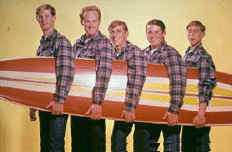
L to R: Brian Wilson, Mike Love, Dennis
Wilson, Carl Wilson, David Marks
Formed in Hawthorne, California in 1961, the group included
brothers Brian, Dennis, and Carl Wilson, their cousin Mike Love,
and friend Al Jardine. Mike sang most of the leads while Brian
led on some of the vocals.

Murry Wilson
The group began as Kenny and the Cadets, Carl and the
Passions, and finally the Pendletones. Brian a fan of the Four
Freshman, began teaching the others intricate Freshman styled
harmonies. Murry Wilson, the father of the brothers and a
songwriter, took the boys to his publisher Hite Morgan who in
turn took the to Keen Recording Studios. Dennis the only
member of the group who surfed thought that it would be a good
subject for a song and suggested it to Brian. Brian then wrote
"Surfin" and with Mike wrote "Surfin'
Safari," songs they made into demos in 1961.
Murry took the demos to Herb Newman, who owned Candix and Era
Records. On December eighth Newman signed the group. Ross Regan,
Era's promotion man, suggested they change their name to the
Beach Boys. In December 1961 "Surfin' was issued on X
Records as a promo and Candix.
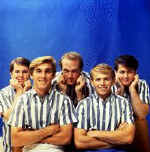
On February 17, 1962, "Surfin" hit the national pop
charts, reaching #75. On New Year's eve the group performed at
its first important show as the Beach Boys at the Long Beach
Municipal Stadium in a memorial concert for Ritchie Valens. They
were paid three hundred dollars.
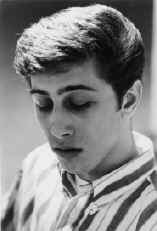
David Marks
In February 1962 Jardine left to study dentistry. On February
8th, Brian, Dennis, and Val Poliuto of the Jaguars recorded six
songs for Hite Morgan's Deck Records. In May Candix went out of
business and Murray Wilson, now the groups manager, began taking
their demos around. Several labels passed on the group, but
Capitol's Nick Venet liked the demo of "Surfin'
Surfari" and signed the group in June. a master of
"Surfin' Safari" was recorded with new member David
Marks, who had replaced Jardine. On August 11, 1962 "Surfin'
Surfari" reached #14 and the flip side "409"
charted at #76.
In early 1963 Jardine returned and Marks his replacement left.
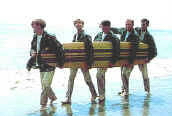
"Surfin' Safari" marked the beginning of the unique
harmonies the group would become known for. This was a new style
of rock and roll with Chuck Berry rhythms and Four Freshman
harmony. "Surfin' U.S.A.," written by Brian Wilson and
Mike Love, was so close to Berry's "Sweet Little
Sixteen" that his threat of a lawsuit got him sole writing
credits. By May 25th it had reached number three in the U.S.A.;
it went on to reach number thirty-two in England and number nine
in Australia. The flip side, a hotrod song, "Shutdown,"
reached number twenty-three.
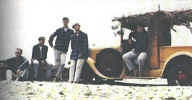
The next surfing/drag racing two sider was the groups' first
ballad "Surfer Girl" (#7 Pop, #18 R&B), along with
Little Deuce Coupe" (#15 Pop).

The Beach Boys "Surfin' U.S.A." went all the
way to number two, denied the top spot by Jan and Dean's
"Surf City," written by their friend Brian Wilson. the
group's popularity was such that two Brian Wilson produced
albums, released almost simultaneous, hit the top ten; Surfer
Girl (#70) and Little Deuce Coupe (#4).

The Beach Boy's next single, "Be True to Your
School" reached number six on December 21, 1963. The flip
side "In My Room" went to number twenty-three.
One of their best rocker's "Fun, Fun, Fun," with
Mike Love on lead and a Chuck Berry intro, reached #5 on March
21, 1964.
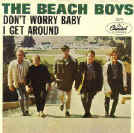
The first number one came next as "I Get Around,"
with Love again on the lead, hit the top spot in early June 1964.
More hits followed in 1964 with "When I Grow Up" (#9)
and "Dance, Dance, Dance" with Brian on the lead
(#8).

Bruce Johnston
Conducting their first major U.S. tour in September, 1964, The
Beach Boys Concert album, recorded in Sacramento, California ,
became the first live album to top the charts. However, on
December 23, while on a plane trip from Houston to Los Angeles,
Brian had a nervous breakdown brought on by an overwhelming
schedule of writing, producing, recording, and touring. Brian
stopped touring with the band and guitarist/singer Glenn Campbell
was brought in to perform for him on the road, who was replaced
by Bruce Johnston in April, 1965.
In 1965 the Beach Boys did a remake of Bobby Freeman's hit
"Do You Wanna Dance" with Dennis Wilson on lead, it
went to number twelve. By April Bruce Johnson of the Ripchords,
had replaced Campbell.
In the spring of 1965 "Help Me Rhonda" became the
groups second number one pushing the Beatles "Ticket to
Ride" out of the top spot.
Despite a hearing lose in his right ear, Brian continued to
write and produce vocal harmony hits. One of them
"California Girls" had a memorable keyboard intro and
with Love on lead reached number three on August 28, 1965. Then
"Barbara Ann" soared to number two nationally with Dean
Torrance of Jan and Dean on lead.

Al Jardine
|
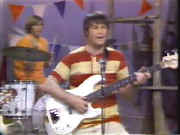
Brian Wilson
|
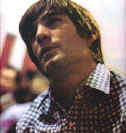
Dennis Wilson
|
"Sloop John B,'" a 1927 folk song , with Al
Jardine went to number three on May 7, 1966.
It was followed by "Wouldn't It Be Nice" (#8). The
flip side, "God Only Knows," though it only reached
number thirty-nine, had the distinction of being called the
greatest love song ever written by Paul McCartney.
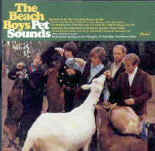
No longer touring, Brian Wilson concentrated on writing for
the Beach Boys and using elaborate production techniques on the
group's recordings. While the rest of the group was touring Brian
began working on the Pet Sounds album, employing scores of studio
musicians and utilizing advanced studio techniques. However,
despite lush orchestral sound and songs such as "God Only
Knows," "Wouldn't It Be Nice," "Caroline
No," and "Sloop John B," Pet Sounds sold poorly
compared to other releases.
Severely disappointed, Brian began work on the next album
Smile. While working on this project Capitol Records released the
Beach Boys next hit. It was a song that Brian and Mike wrote and
Brian spent six months working on. The song recorded in
seventeen different sessions in four Los Angeles studios and cost
over sixteen thousand dollars, was "Good Vibration".
Influenced by Phil Spector, Brian built a heavily overdubbed and
echoed rock symphony that appealed to the public. complexities
and all. On December 10. 1966 it reached number one.
Meanwhile, Brian began behaving erratically as rumors of
heavy drug use circulated. For whatever reason Smile was not
released. Smiley Smile was released on the group's recently
formed label, Brother Records, distributed by Capitol.
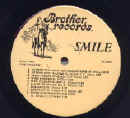
It took Capitol Records ten months to release the Beach Boy's
next single "Heroes and Villains," a complex but less
commercial record which reached number twelve.
Pulling out of a scheduled appearance at the Monterey
International Pop Festival in June, 1967 The Beach Boys met
Maharishi Mahesh Yogi In December. Their fascination with his
transcendental meditation culminated with a near disastrous tour
with him in the spring of 1968.
The group's next recordings were straight rock, "Wild
Honey" (#31 1967), "Darlin'" (#19 1967), "Do
It Again" (#20 1968), and "I Can Hear Music" (#24
1969.)
In the summer the Beach Boys recorded their last record for
Capitol, "Break Away (#63 1969). They then signed with
Warner Brother's Reprise label and charted May 7, 1970 with
"Add Some Music to Your Day" (#64).

Bruce Johnston
|
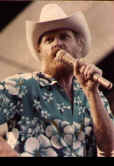
Mike Love
|
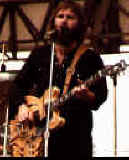
Carl Wilson
|
In the late 60s the Beach Boys imaged suffered as they were
perceived as an oldies group in the midst of the progressive rock
movement. That changed in 1970 when they appeared at the Big Sur
Festival in North California, making fans out of the new hip rock
crowd.
They solidified that status in February 1971, playing Carnegie
Hall in New York to an overwhelming response and sharing billing
with the Grateful Dead at the Fillmore East in April.
In 1972 Dennis was sidelined after he injured his hand because
of a windowpane mishap. Bruce Johnson left for a solo career.
They were replaced by Rick Fataar and Blondie Chaplin of the
South African group Flame.
Meanwhile, their Warner Brothers records weren't as high
quality as their Capitol sides. A reissue by Capitol of
"Surfin' U.S.A". in the summer of 1974, reached #6,
higher than any of the six singles they had done for Warner
Brothers. The Warner Brothers material was getting more
creative input from the group and less from Brian.
Brian returned to produce the 15 Big Ones album. The
album included "Rock and Roll Music" that brought the
group back to the top five for the first time in ten years.
The album contained mostly oldies and hit number eight.
By now Dennis was back and Fataar and Chaplin were out.
That year the Beach Boys sang back up for Chicago's hit
"Wishing You Were Here" (#11).
In 1977, the Beach Boys signed with Caribou records and by
1979 charted with a disco flavored remake of "Here Comes the
Night" (#44) originally on their Wild Honey album.
Johnson rejoined the group in 1979. On July 4, 1980 the Beach
Boys played a free concert in Washington, D.C. before a half
million people, which became an annual event through the
eighties.
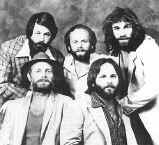
Mike Love became the front man for The Beach Boys during the
'80s, as Brian Wilson began a rehabilitation program under
therapist Eugene Lundy between 1985 and 1988.
In December 1983, Dennis Wilson drowned while swimming
alongside of his boat at Marina Del Ray Harbor in Los Angeles, an
ironic twist of fate for the only actual surfing Beach Boy.
In 1985 the Beach Boys recorded their best original record
since the early days. With Mike Love on lead and Brian's strong
falsetto "Getcha Back" and its harmony right out of the
Mystics "Hushabye," reached number twenty-six.. Next
came "Rock and Roll to the Rescue (#68 1986) and a remake of
the Mama and Papa's "California Dreamin'" (#57 1986).
The Beach Boys performed at Ronald Reagan's Inaugural in
January 1985 and Live Aid the following July. In 1987 they had a
major hit with a remake of the surf classic "Wipeout,"
recorded with the Fat Boys rap group.
In 1988, the Beach Boys had a number one hit with the
Jamaica-rhythm "Kokomo," from the film Cocktail, with
Mike on the lead.
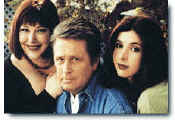
Carnie, Brian, and Wendy Wilson
By 1988, Brian Wilson's daughters Carnie and Wendy had formed
the vocal group Wilson Phillips with Chynna Phillips, oldest
daughter of John and Michelle Phillips of The Mamas and the
Papas. Their debut album produced five hits, including "Hold
On," "Release Me," and "You're In Love."
By 1993 Wilson Phillips had disbanded. Carnie and Wendy Wilson
soon recorded the Christmas album Hey! Santa and later recorded
as The Wilsons for Mercury Records.
An amazing barometer of their appeal is that between 1961 and
1981 they were only off the charts two years, 1972 and 1979.

Beach Boys 2012
Bruce Johnston, Al Jardine, Brian Wilson, Mike Love, David, Marks

The Beach Boys' star on the Hollywood Walk of Fame
In early 2024, it was announced that Brain Wilson
was suffering from dementia, and a conservatorship was
established at that time for his immediate personal needs after
the death of his wife, Melinda Ledbetter Wilson.
Brian Wilson died June 11, 2024 at the age of 82
Dennis Wilson died December 28, 1983, drowning at Marina Del Ray,
California. at the age of 39.
Carl Wilson died of lung and brain cancer in Los Angeles,
California February 6, 1998, he was 51.
The Beach Boys were inducted into the Rock and Roll
Hall of Fame in 1988.
The Beach Boys were inducted into the Vocal
Group Hall of Fame in 1998.
























